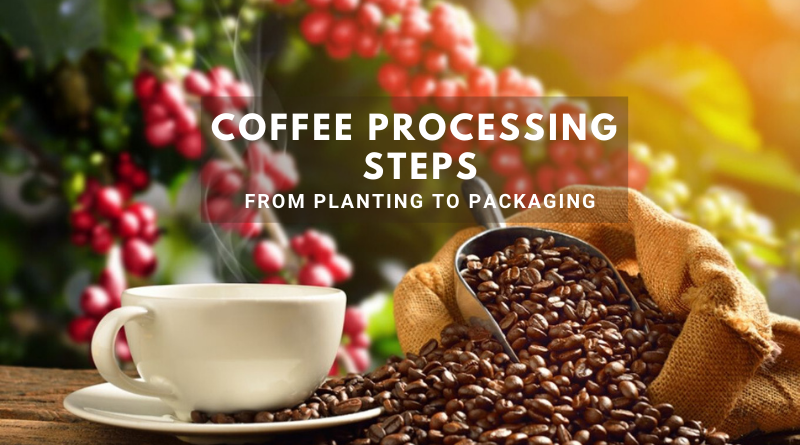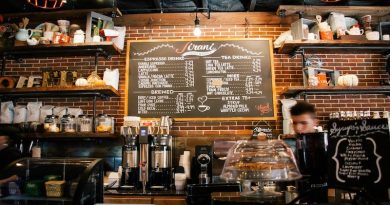Ultimate Guide To Coffee Processing Steps – From Planting To Packaging
A Coffee bean is a seed of the Coffea plant and the hotspot for coffee. It is the pit inside the red or purple fruit also called cherry. Coffee began from the landmass of Africa in the nation of Ethiopia. From that point, throughout the long term, Coffee beans relocated to South East Asia, Central, and South America. The coffee fruit goes through a long journey before it becomes a consumable product. Read through this ultimate guide for every step that plays a crucial role in coffee processing.
Also, read the great western coffee culture and the coffee culture in the Middle East, Africa and Asia.
Steps For Coffee Processing
Planting
The very first step of coffee processing is planting a good coffea plant. Check out the climate condition, soil type and seeding method used for coffee planting.
Climatic conditions
The Coffee Arabica can be developed at a high elevation from 900 meters to 1600 meters. The coffee crop develops well with an equitably circulated yearly precipitation of 2,200 to 2300 mm. This yield is extremely delicate to high precipitation conditions and this may cause spoiling of leaves and parasitic infection. The Ideal temperature of 10°C – 28°C is needed for acceptable development.
Soil requirement
Coffee harvest can be developed on a different kind of soils. Soil is the directing variable in the plantation of coffee. The ideal soil is unified with a decent subsurface waste, and one that is effectively serviceable. The presence of humidity and other nitrogenous matter in the dirt is a bonus as it would benefit the coffee harvest. For great quality of coffee beans, the pH of the dirt ought to be between 5.0 – 6.0.
Seedling
The coffee crop is spread by seeds and cuttings. Eliminate any mash from seeds by hand and these seeds ought to be scoured with debris to abstain from any staying. Coffee seeds ought to be permitted to dry under shade. It is prescribed to plant these seeds 2.5 cm separated. It takes around 30 to 40 days for germination after because period planting in the field or nursery beds. These coffee seedlings ought to be removed and relocated into polythene packs or in nursery beds at a dividing of 25 cm.
Harvesting
The next step in coffee processing is picking up the right fruit. Coffee fruit, the organic product is taken out from the trees utilizing one of two cycles: strip picking or specific picking. In strip picking, the entirety of the coffee natural product is eliminated from the tree paying little heed to development.
In specific picking, the ready, red cherries are collected, and this is for the most part done by hand. This interaction is more work concentrated than the strip picking and is by and large utilized for better arabica beans.
Processing
There are three known methods of coffee processing as far as coffee beans are concerned. Dry coffee bean processing is a more established procedure. Wet processing, which is a more current strategy for coffee bean processing, and honey processing.
Dry processing
It is the most seasoned technique for coffee processing. In this method, the beans are set in the sun and left to dry for around fourteen days while being abandoned from chance to time so they can dry uniformly.
Wet Processing
Wet processing is an advanced strategy for coffee processing and it happens not long after the beans are collected. This coffee gathering measure comprises washing and maturation. During this interaction, the mash that is left on the beans will become gentler and the mash is washed off.
Today, this technique is utilized all the more habitually since it forestalls harm to the beans.
Honey Processing
This method is used normally for the most part in Central American nations like Costa Rica and El Salvador. In the honey processing method, coffee cherries are picked and arranged. Outer skin and pulp are removed from cherries in this processing method. After this, it is left to be dried without washing the mucilage. For good quality, coffee beans are dried for 3-5 weeks under the shade. On the basis of different amount of mucilage three types of coffee comes under this processing category-
1. yellow( least amount of mucilage )
2. red( moderate amount of mucilage)
3. black (maximum amount of mucilage)
Roasting
The roasting step in the coffee processing changes green coffee into the sweet-smelling earthy-colored beans that we buy in our number one stores or bistros. Beans are regularly roasted in huge business roasters, putting beans in huge metal chambers and blowing hot air on them. The more established technique simmered over an electric, gas, or charcoal radiator.
Broiling continuously raises the temperature of the beans to somewhere in the range of 180°C and 230°C. This triggers the arrival of steam, making the beans swell just as obscure in shading and create cooked flavors.
There are various kinds of roasts – light, medium and dull – and inside these roast, each has a couple of levels:
Light Roast
It doesn’t create any oil on the outside of the coffee beans. Beans are light or a moderate light earthy coloured tone.
Medium Roast
Beans are a medium-light to medium earthy coloured tone and are created during the primary break.
The Dull Roast
It produces dim burned beans that have a great deal of oil on a superficial level. Dull dishes occur after the subsequent break. Contingent upon the broiling temperature, the tone fluctuates from medium dull earthy colored to almost dark.
Hulling and Polishing
Hullers are utilized to eliminate what is left of the organic product on the bean. It could be the brittle material skin of wet-handled espresso or the material skin and dried adhesive of semidry-prepared coffee or the whole calfskin natural product in dry-handled coffee. This step is a vital one in coffee processing as it enhances the look of the roasted beans.
Cleaning, Sorting, and Grading
Cleaning is a discretionary strategy that eliminates any leftover silver skin from the beans following hulling. It is done to improve the presence of the green beans. Care should be taken because the temperatures experienced by the beans during cleaning might be unfavorable to conclusive coffee flavor.
Fine coffee is arranged and cleaned through a multistep cycle. Air sorters, strainer shakers, and gravity separators are utilized to isolate dependent on thickness and size. Shading arranging is performed utilizing machines or by hand. The last review depends on size, developing area and height, gathering, taste, and cup quality.
Coffee tasting
Coffee is over and over tried for quality and taste. This cycle is alluded to as measuring and typically happens in a room explicitly intended to encourage interaction.
Acidity
Acidity depicts the degree of sharpness of espresso. High corrosiveness coffee is believed to be better. Low corrosiveness coffee is typically called take-off.
Body
The body and delayed flavor impression are different terms used to portray the coffee. The ‘body’ alludes to how the coffee feels in the mouth – for example, it might feel hefty or very light. This quality is, somewhat, steady and doesn’t rely upon singular tastes.
Coffee Grinding
This is an extremely technical step in coffee processing as the target is to get an appropriate granulate to get the most flavor in the coffee. How coarse or fine the coffee is ground relies upon the preparing technique.
The period of time the grounds will be in contact with water decides the ideal evaluation of granulate. Generally, the better the crush, the more rapidly the coffee ought to be readied. That is the reason coffee ground for a coffee machine is a lot better than coffee prepared in a dribble framework.
Packaging
Coffee packaging is the last step in coffee processing yet vital, as any openness to air could transform the coffee into a bump. This is particularly the situation for ground coffee, which can rapidly lose its flavor whenever presented to air. This is the motivation behind why coffee is generally pressed in hermetically sealed compartments and ought to be resealed cautiously when not being used.




